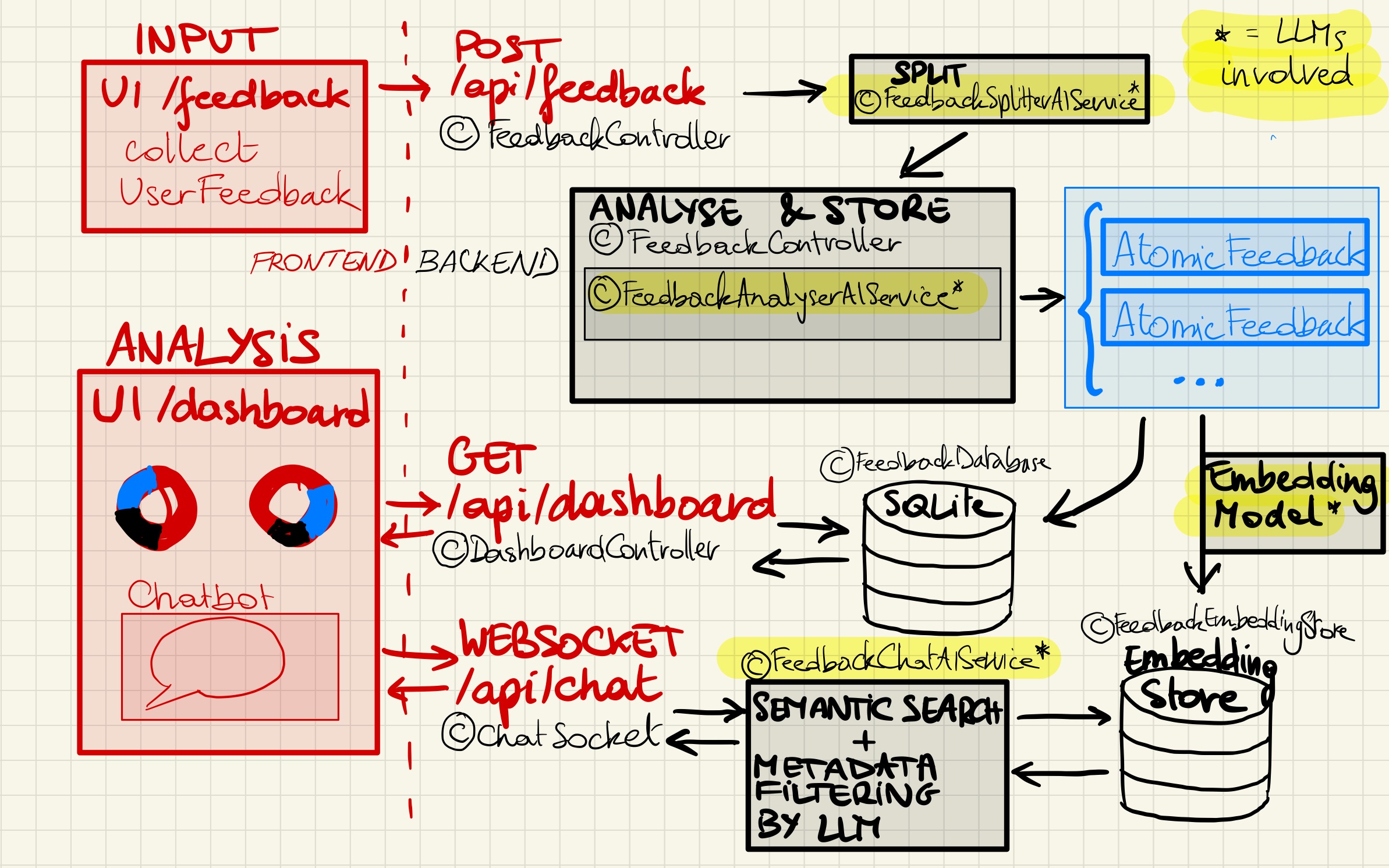This application is meant to illustrate various LangChain4j building blocks and capabilities in a real application that also includes endpoints, frontend and databases. We wrapped the plain java code in a Quarkus web-application (for a fast and lightweight application), added a frontend (partly plain html, partly React) an SQLite database and provided Docker files for deployment.
You can concentrate on the business logic and use this project as a template for your own AI-powered projects.
This is the architecture of the application.
TODO add table of content
To get this application running, you'll need
- Java 8 or higher
- Maven
- A key for the OpenAI API
- Docker (optional)
- Store the OpenAI API key as environment variable
OPENAI_API_KEYor register it inapplication.properties, and restart your IDE if needed - The dependencies for quarkus and it's LangChain4j integration are already in the
pom.xmlfile.
To run the application, execute the following command in the project root:
mvn quarkus:devEnter your feedback at http://localhost:8080/feedback
Observe the analysis and chat with the results at http://localhost:8080/dashboard
To stop the application, press Ctrl+C in the terminal
Database entries will be persisted even when stopping and restarting the application,
unless you specify otherwise in application.properties.
Changes to the java code and html files will be hot-reloaded, so you can see the changes immediately in your browser.
You can access the Quarkus Dev Console at http://localhost:8080/q/dev/ to see the status of the application, set parameters and inspect the logs.
TODO
We tried to stay as close to plain java as possible for the LangChain4j services, to allow all developers, regardless of their usual framework, to understand what’s happening after they worked through the BASIC TUTORIAL.
If you are building a deviated product yourself, it is recommended to exploit the configuration and injection options offered by the framework of your choice (Quarkus or Spring Boot) to the maximum. At some places in the code, pointers for proper Quarkus use are given in the comments.
This demo is a work in progress and is missing important features like proper logging, good error handling, observability, unit tests and documentation. It will come at some point :)
The goal of this example is to give you a feel of the versatility of LangChain4j capabilities in a real-world set-up. What I hope you will take over for your own projects:
- A range of AiService usages (RAG-powered chat, splitter, analyser returning POJO)
- How to use LangChain4j with a front-end (endpoints and chatsocket)
- Persisting AI-processed data to both a classical database (SQLite) and an embedding store (InMemoryEmbeddingStore)
- Set-up of a webservice wrapper around plain LangChain4j code (Quarkus in this case, similar for Spring Boot) and it’s lifecycle aspects (StartupService, sessions, applicationScoped)
- Adapt our html to your use case
- Generating a Docker Image
What I hope you will do better:
- Add testing, proper error handling, logging and observability
- Exploit the configuration and injection capabilities of your framework better (LangChain4j has integrations with Quarkus or Spring Boot)
- Call your repo analyZer with a z...
TODO
We are setting up an SQLite database. This will allow us to store our database data in a file stored_feedback.db, within in our project. Stored_feedback.db is listed under .gitignore, so make sure to remove it from there if you would want to push your collected data to your repo.
In the normal cycle, upon application startup, the class StartupService.java will make sure the database tables are present by running create_tables.sql and create_tags.sql. If the database file is not yet there, it will be created in the folder resources/META-INF.resources. If the tables are already there, nothing will happen. That’s some of the conveniences of SQLite :) You can inspect what’s in your database by opening stored_feedback.db and if needed, install an IDE plugin to have a proper look at the data in there.
If during development, you make changes to the schema, or if you want to wipe your data,
you can use the property app.database.reset (default false) to force a run of drop_tables.sql
before re-initializing the database. Don’t forget to set the property back to false afterwards.
If you want to load some demo data, use the property app.database.prepopulate (default false)
to indicate that the file populate_with_demo_data.sql has to be run on startup.
Don’t forget to set the property back to false afterwards.
When stopping the application (Ctrl+C), the database stays intact.
The frontend consists html files under src/main/resources/META-INF.resources.
The Quarkus framework will ensure these are served on /filename.html
There are two static html files (feedback.html,dashboardwithchat.html)
and one React html file (dashboard.html) with it's scripts under /assets.
The static html files are built with tailwind CSS so it adapts to the screen width (reactivity).
This static html should be easy to adapt for your own use case.
In feedback.html you’ll find an example of a webform content POST (JSON format),
that will also handle the response of the backend and show it in the UI.
To see what this gives in the UI, run the application and go to localhost:8080/feedback.html
TODO IMAGE of /feedback
A part of the frontend (dahsboard.html) is in React, which is harder and rather unadaptable,
but illustrates the possibilities better.
TODO IMAGE of /dashboard
To give you a starting point for your own WebSocket handling on the frontend side (needed to build a chatbot),
we left the example dashboardwithchat.html in (observe on localhost:8080/dashboardwithchat.html).
For a deeper dive, have a look at:
- LangChain4j Documentation
- Tutorials
- Examples for all dependencies and frameworks integrating with LangChain4j
- LangChain4j Repo
- TODO link to community examples

